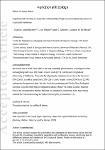Experimental warming increases the vulnerability of high‐elevation plant populations to a specialist herbivore
| dc.contributor.author | Buckley, James | |
| dc.contributor.author | Widmer, A | |
| dc.contributor.author | Mescher, MC | |
| dc.contributor.author | De Moraes, CM | |
| dc.date.accessioned | 2023-04-11T11:51:30Z | |
| dc.date.available | 2023-04-11T11:51:30Z | |
| dc.date.issued | 2023-03-27 | |
| dc.identifier.issn | 0269-8463 | |
| dc.identifier.issn | 1365-2435 | |
| dc.identifier.uri | https://pearl.plymouth.ac.uk/handle/10026.1/20666 | |
| dc.description.abstract |
Ongoing climate change may impact alpine plant populations via both direct effects of increased temperature and climate-driven changes in interactions between plants and other organisms, such as insect herbivores. Rates of herbivory in high-elevation environments are predicted to increase with warmer temperatures, which may also lead to changes in morphological and physiological traits that influence plant resistance. Yet, we currently know little about how temperature-mediated changes in traits will impact alpine plant vulnerability to herbivores, as well as the extent to which populations from high-elevation environments might need to rapidly adapt to increasing herbivore pressure with rising temperatures. We assessed the effect of experimental warming on the relative vulnerability of populations of the alpine plant Arabis alpina from different elevations to a specialist herbivore. Herbivore performance was measured on plants from nine populations grown in climate chambers at two temperatures, representing low (warm) and high (cold) elevations. We also measured changes in putative drivers of performance: plant phenological, chemical and defence traits. Assuming populations would be adapted to local climates and levels of herbivory, we predicted that low-elevation populations would be more resistant to herbivores under warmer temperatures than high-elevation populations. We found reduced performance of a specialist herbivore on A. alpina grown under warm rather than cold conditions, though this effect varied with elevation. Larvae grew faster on high-elevation populations than low-elevation populations when grown under warm temperatures, whereas similar growth rates were observed for plants grown under colder temperatures, consistent with plant adaptation to the lower existing herbivore pressure in cold, high-elevation environments. Regression analyses suggested that polar metabolite variation explained more variance in larval performance than changes in defensive glucosinolates or morphological traits. Our results suggest that although physiological responses to warming may increase the resistance of cold-adapted plants to herbivory, populations from different elevations may differ in their interactions with herbivores under climate warming. Without genetic adaptation, existing physiological responses of high-elevation populations to warmer temperatures may leave these populations vulnerable to the increases in herbivore pressure predicted under climate change. | |
| dc.format.extent | 1536-1552 | |
| dc.language | en | |
| dc.publisher | Wiley | |
| dc.subject | alpine | |
| dc.subject | climate change | |
| dc.subject | defence | |
| dc.subject | elevation | |
| dc.subject | glucosinolates | |
| dc.subject | herbivory | |
| dc.subject | metabolites | |
| dc.subject | plasticity | |
| dc.title | Experimental warming increases the vulnerability of high‐elevation plant populations to a specialist herbivore | |
| dc.type | journal-article | |
| dc.type | Journal Article | |
| plymouth.author-url | https://www.webofscience.com/api/gateway?GWVersion=2&SrcApp=PARTNER_APP&SrcAuth=LinksAMR&KeyUT=WOS:000967787100001&DestLinkType=FullRecord&DestApp=ALL_WOS&UsrCustomerID=11bb513d99f797142bcfeffcc58ea008 | |
| plymouth.issue | 6 | |
| plymouth.volume | 37 | |
| plymouth.publication-status | Published | |
| plymouth.journal | Functional Ecology | |
| dc.identifier.doi | 10.1111/1365-2435.14324 | |
| plymouth.organisational-group | |Plymouth | |
| plymouth.organisational-group | |Plymouth|Faculty of Science and Engineering | |
| plymouth.organisational-group | |Plymouth|Faculty of Science and Engineering|School of Biological and Marine Sciences | |
| plymouth.organisational-group | |Plymouth|REF 2021 Researchers by UoA | |
| plymouth.organisational-group | |Plymouth|Users by role | |
| plymouth.organisational-group | |Plymouth|Users by role|Academics | |
| plymouth.organisational-group | |Plymouth|REF 2021 Researchers by UoA|UoA06 Agriculture, Veterinary and Food Science | |
| dcterms.dateAccepted | 2023-03-06 | |
| dc.date.updated | 2023-04-11T11:51:22Z | |
| dc.rights.embargodate | 2023-4-13 | |
| dc.identifier.eissn | 1365-2435 | |
| dc.rights.embargoperiod | forever | |
| rioxxterms.versionofrecord | 10.1111/1365-2435.14324 |


